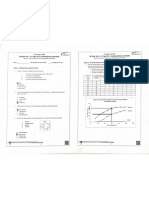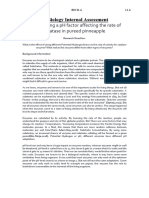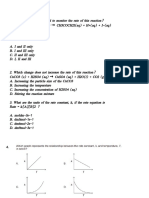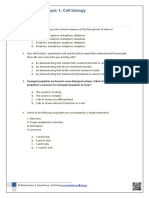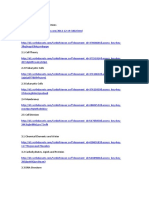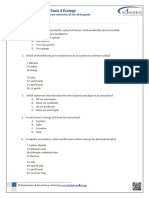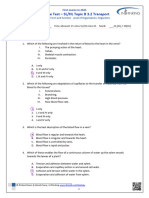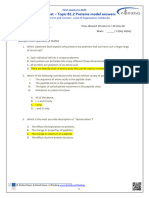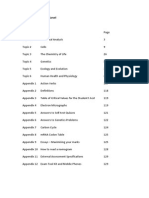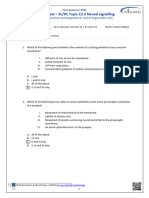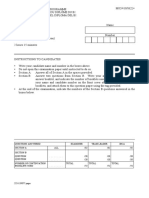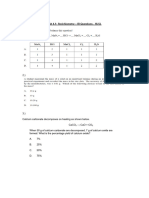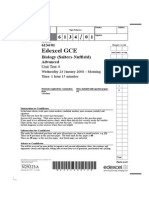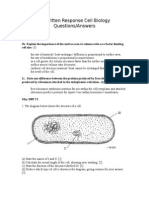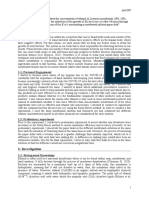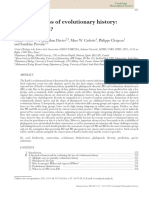A4 1 Topic Test
A4 1 Topic Test
Uploaded by
Paridhi BhandariCopyright:
Available Formats
A4 1 Topic Test
A4 1 Topic Test
Uploaded by
Paridhi BhandariOriginal Title
Copyright
Available Formats
Share this document
Did you find this document useful?
Is this content inappropriate?
Copyright:
Available Formats
A4 1 Topic Test
A4 1 Topic Test
Uploaded by
Paridhi BhandariCopyright:
Available Formats
First exams in 2025
IB Style Test – SL/HL Topic A4.1 Evolution and speciation
Theme A: Unity and diversity Level of Organisation: Ecosystems
Name ___________________ Time allowed: 20 mins SL / 30 mins HL. Mark: / 18(SL)26(HL)
Section A Multiple choice (4 marks)
1. Which of the following is the most accurate definition of evolution?
A. The formation of two species from a single species.
B. The change in populations caused by mutation.
C. The change in the heritable characteristics of a population.
D. The change in the physical characteristics of a population.
2. There are many different domesticated breeds of cattle descended from the wild ox
about 10,500 years ago. What is the term that describes the formation of new breeds of
farmed cattle?
A. Inbreeding.
B. Selective breeding.
C. Natural selection.
D. Speciation.
3. The lion (Panthera leo) and the tiger (Panthera tigris) are believed to have evolved from
a recent common ancestor. What is the name for this type of evolution?
A. Isolation.
B. Polyploidy.
C. Survival of the fittest.
D. Speciation.
4. Which of the following is not regarded as evidence for evolution by natural selection?
A. Selective breeding.
B. Homologous structures.
C. Analogous structures.
D. DNA base sequences.
© Richard Scarr & David Faure, InThinking www.thinkib.net/biology
1
First exams in 2025
IB Style Test – SL/HL Topic A4.1 Evolution and speciation
Theme A: Unity and diversity Level of Organisation: Ecosystems
Structured answer question (8 marks)
5. The image is of a fossil of Magallena gryphoides from Crete, Greece from the Early
Tortonian Age approximately 9 million years bp (before present). This fossil organism is
related to present day oysters (Ostreidia family).
The graph shows the relationship between the length and the width of the fossilised
shell (courtesy Nikos Marangos).
Magalenna gryphoides width versus length
180.00
160.00
Width / mm (± 0.01mm)
140.00
120.00
100.00
80.00
60.00
100.00 150.00 200.00 250.00 300.00 350.00 400.00 450.00 500.00
Length / mm (± 0.01mm)
a) The uncertainty of measurement is estimated at 0.01mm. Suggest a measuring instrument
that could have been used to achieve this degree of accuracy. (1 mark)
.............................................................................................................................................
..............................................................................................................................................
b) List two other uncertainties that would have to be considered in evaluating the data in this
investigation. (2 marks)
.............................................................................................................................................
..............................................................................................................................................
c) Describe the relationship between the length of the shells and the width of the shells.
(2 marks)
.............................................................................................................................................
..............................................................................................................................................
© Richard Scarr & David Faure, InThinking www.thinkib.net/biology
2
First exams in 2025
IB Style Test – SL/HL Topic A4.1 Evolution and speciation
Theme A: Unity and diversity Level of Organisation: Ecosystems
d) The dimensions of the largest shell are 451.90mm length and 159.62mm width. Deduce
whether this specimen could be considered as an outlier in the data. (1 mark)
.............................................................................................................................................
..............................................................................................................................................
e) Suggest why fossils could be regarded as evidence of evolution by natural selection.
(2 marks)
.............................................................................................................................................
..............................................................................................................................................
..............................................................................................................................................
Extended response question (6 marks)
6. Explain why analysis of base sequences of DNA can provide evidence of biological
evolution from a common ancestor. (2 marks)
.............................................................................................................................................
Similarity in base sequence would mean common ancestry
..............................................................................................................................................
..............................................................................................................................................
.............................................................................................................................................
7. Distinguish between analogous and homologous structures. (4 marks)
..............................................................................................................................................
..............................................................................................................................................
Analogous structure mean they don’t look the same but functions are the same like:_ Dolphin
and a Crocodile’s bone structure — Evolution dekhaudeina
.............................................................................................................................................
Homologous mean not the same function, necessarily not the same structure of the bone like :-
..............................................................................................................................................
humans and bats -
..............................................................................................................................................
.............................................................................................................................................
..............................................................................................................................................
..............................................................................................................................................
© Richard Scarr & David Faure, InThinking www.thinkib.net/biology
3
First exams in 2025
IB Style Test – SL/HL Topic A4.1 Evolution and speciation
Theme A: Unity and diversity Level of Organisation: Ecosystems
Additional Higher Level only questions (8 marks)
8. Outline the process that allows new species to evolve from a single species in the same
habitat to avoid competition for resources. (4 marks)
..............................................................................................................................................
..............................................................................................................................................
.............................................................................................................................................
..............................................................................................................................................
..............................................................................................................................................
.............................................................................................................................................
..............................................................................................................................................
..............................................................................................................................................
8. Explain how reproductive isolation can maintain the divergent evolution of two separate
species occupying the same habitat. (4 marks)
..............................................................................................................................................
..............................................................................................................................................
.............................................................................................................................................
..............................................................................................................................................
..............................................................................................................................................
..............................................................................................................................................
..............................................................................................................................................
.............................................................................................................................................
..............................................................................................................................................
© Richard Scarr & David Faure, InThinking www.thinkib.net/biology
4
You might also like
- Carbohydrates and LipidsDocument2 pagesCarbohydrates and LipidsIsabella PeheNo ratings yet
- Chemistry HL p2Document871 pagesChemistry HL p2andy.hy.chanNo ratings yet
- IB Style Test - Topic 5: Evolution and Biodiversity: Includes New Elements of The 2016 GuideDocument7 pagesIB Style Test - Topic 5: Evolution and Biodiversity: Includes New Elements of The 2016 GuideDahlia Rose100% (3)
- A1.1 Water - Topic TestDocument3 pagesA1.1 Water - Topic TestAnkit MistryNo ratings yet
- 9201 Question Paper1 International Gcse Biology Jun22Document32 pages9201 Question Paper1 International Gcse Biology Jun22asdf100% (1)
- IB Biology: Topic 2 Past Exam Data QuestionsDocument13 pagesIB Biology: Topic 2 Past Exam Data QuestionsJune Chow100% (2)
- IB BIOLOGY 1ed TR Workbook AnswersDocument99 pagesIB BIOLOGY 1ed TR Workbook Answersღ꧁Lizzy X Roxiie꧂ღ100% (1)
- A1.2 2025 Topic Test v3Document5 pagesA1.2 2025 Topic Test v3valentinaNo ratings yet
- IB Chemistry - HL Topic 7 QuestionsDocument5 pagesIB Chemistry - HL Topic 7 QuestionsPisosNo ratings yet
- T1-2 T (IB Biology Topic 2 Question Bank)Document32 pagesT1-2 T (IB Biology Topic 2 Question Bank)Kunakorn Kunthamas50% (2)
- IB Biology Internal Assessment Term 3 FinalDocument9 pagesIB Biology Internal Assessment Term 3 FinalCindy Julia Amanda100% (1)
- IB - Ch6 - 16 Past PapersDocument33 pagesIB - Ch6 - 16 Past Papersrejymol100% (1)
- Mountain HighDocument26 pagesMountain HighQuercusBooksNo ratings yet
- ESS Paper 2 (20 Mark) Exemplar ResponsesDocument5 pagesESS Paper 2 (20 Mark) Exemplar ResponsesjinL100% (1)
- Creep Failure of HP Modified Reformer TubeDocument20 pagesCreep Failure of HP Modified Reformer Tubearaujo angel100% (1)
- IB Style Test Topic 1: Cell Biology: Multiple Choice QuestionsDocument8 pagesIB Style Test Topic 1: Cell Biology: Multiple Choice QuestionsSneha Kumari100% (2)
- IB Biology Revision Notes FULLDocument3 pagesIB Biology Revision Notes FULLAtulya BharadwajNo ratings yet
- The Global Case For Strategic Asset Allocation and An Examination of Home Bias - Thierry PollaDocument20 pagesThe Global Case For Strategic Asset Allocation and An Examination of Home Bias - Thierry PollaThierry PollaNo ratings yet
- A2 1 2025 Origin Cells Topic TestDocument3 pagesA2 1 2025 Origin Cells Topic TestBRADRY ORANGO100% (1)
- D 2 1 2025 Topic TestDocument4 pagesD 2 1 2025 Topic Testkarinaajani11No ratings yet
- Transfers of Energy and MatterDocument3 pagesTransfers of Energy and MatterParidhi BhandariNo ratings yet
- A 4.1 Evolution & Speciation - Model AnswersDocument4 pagesA 4.1 Evolution & Speciation - Model AnswersAnkit MistryNo ratings yet
- Populatios and CommunitiesDocument5 pagesPopulatios and CommunitiesParidhi BhandariNo ratings yet
- C 1 3 2025 Topic Test MsDocument5 pagesC 1 3 2025 Topic Test MsRawanMazen Sharif0% (1)
- 04 Ecology TestDocument7 pages04 Ecology TestFrancisNo ratings yet
- A1.2 Nucleic Acids Topic Test - Model AnswersDocument5 pagesA1.2 Nucleic Acids Topic Test - Model AnswersAnkit MistryNo ratings yet
- Molecular Biology Paper 1 - IB BiologyDocument6 pagesMolecular Biology Paper 1 - IB BiologyJohnathan ChargaffNo ratings yet
- Cells Questions Magnification CalculationsDocument15 pagesCells Questions Magnification CalculationssophiaNo ratings yet
- A1.1 2025 Topic Test - v4Document4 pagesA1.1 2025 Topic Test - v4tom.pallgenNo ratings yet
- B3.2 TransportDocument4 pagesB3.2 TransportIsabella PeheNo ratings yet
- A2.3 Viruses HL - Model AnswersDocument3 pagesA2.3 Viruses HL - Model AnswersAnkit Mistry100% (2)
- C 1 1 2025 Topic Test MsDocument4 pagesC 1 1 2025 Topic Test MsRawanMazen SharifNo ratings yet
- B 1 2 2025 - Topic Test MsDocument3 pagesB 1 2 2025 - Topic Test MsalaqeedinoorNo ratings yet
- DP1 BIO - Test - Topic 1 Paper 1 PDFDocument6 pagesDP1 BIO - Test - Topic 1 Paper 1 PDFSaima SyedaNo ratings yet
- Biology IADocument11 pagesBiology IATijana TosicNo ratings yet
- Markscheme: M13/4/BIOLO/SP2/ENG/TZ2/XX/MDocument9 pagesMarkscheme: M13/4/BIOLO/SP2/ENG/TZ2/XX/MFrank Antonio Quispe TorresNo ratings yet
- IB-Biology-SL Ocs Revision GuideDocument1 pageIB-Biology-SL Ocs Revision Guidetg206No ratings yet
- Top 22 Biology Internal AssessmentDocument1 pageTop 22 Biology Internal AssessmentNatasha BaranovaNo ratings yet
- IB Biology Data Base Questions 38 MarksDocument9 pagesIB Biology Data Base Questions 38 Marksyiota100% (1)
- 5 - IB Biology Required Practical 5 - Mesocosms - IBDP - Lab Experiment GuideDocument5 pages5 - IB Biology Required Practical 5 - Mesocosms - IBDP - Lab Experiment GuidemelindahofmannNo ratings yet
- IB Style Test SL/HL Topic B2.3 Cell SpecialisationDocument4 pagesIB Style Test SL/HL Topic B2.3 Cell SpecialisationIsabella PeheNo ratings yet
- IB Biology: Topic 7 Nucleic AcidsDocument2 pagesIB Biology: Topic 7 Nucleic AcidsbanyNo ratings yet
- Bio Neural SignallingDocument3 pagesBio Neural SignallingIsabella PeheNo ratings yet
- Biology Paper 2 HLDocument7 pagesBiology Paper 2 HLPaula Medio TorrubianoNo ratings yet
- IB Chemistry: Unit 4 Stoichiometry QuestionsDocument37 pagesIB Chemistry: Unit 4 Stoichiometry QuestionsmjohnmccNo ratings yet
- All Biology Past Papers: EdexcelDocument516 pagesAll Biology Past Papers: EdexcelJames Lloyd100% (4)
- Chap 3Document225 pagesChap 3Vishnu Sharma0% (1)
- Marking Scheme For Core Worksheet - Chapter 6Document3 pagesMarking Scheme For Core Worksheet - Chapter 6Anusha PatelNo ratings yet
- IB Multiple Choice Past Paper Questions Topic 1 2012Document3 pagesIB Multiple Choice Past Paper Questions Topic 1 2012mamta2111No ratings yet
- IB Written Response Cell Biology AnswersDocument5 pagesIB Written Response Cell Biology AnswersJulide Catherine Yanikomeroglu100% (1)
- Database Question+++Document8 pagesDatabase Question+++ranasalaheddin1981No ratings yet
- Ib Bio Topic 2.2 Worksheet (Answers)Document2 pagesIb Bio Topic 2.2 Worksheet (Answers)Farida67% (3)
- B1.1 - Carbohydrates and LipidsDocument4 pagesB1.1 - Carbohydrates and LipidslittleianlauNo ratings yet
- IB Style Test - Topic 2: Molecular Biology: Multiple Choice QuestionsDocument6 pagesIB Style Test - Topic 2: Molecular Biology: Multiple Choice QuestionsHilary YuNo ratings yet
- Biology IADocument13 pagesBiology IAMilla Ramnebro100% (1)
- C 1 2 2025 Topic Test MsDocument4 pagesC 1 2 2025 Topic Test MsRawanMazen SharifNo ratings yet
- IB Biology HL Essay QuestionsDocument71 pagesIB Biology HL Essay Questionssms100% (2)
- Chemistry Paper 1 TZ1 HLDocument21 pagesChemistry Paper 1 TZ1 HLMohamed Ahmed FarahNo ratings yet
- B2.2 Vesicle-Compartments-QnsDocument2 pagesB2.2 Vesicle-Compartments-QnsParidhi BhandariNo ratings yet
- Ib Chemistry Answers s2Document40 pagesIb Chemistry Answers s2Gian Paolo GerzonNo ratings yet
- Predicting Loss of Evolutionary History: Where Are We?Document21 pagesPredicting Loss of Evolutionary History: Where Are We?QuinitoNo ratings yet
- Jovaniand Rohwer Biol Rev 2016Document16 pagesJovaniand Rohwer Biol Rev 2016Hari KalyanNo ratings yet
- Cocoheal Detailed Scientific SummaryDocument11 pagesCocoheal Detailed Scientific Summarymeenatchi sunndharNo ratings yet
- FMG90 Series: With PVDF and 316L ConstructionDocument2 pagesFMG90 Series: With PVDF and 316L ConstructionRavi RanjanNo ratings yet
- StructuralismDocument35 pagesStructuralismEmy Asmida100% (3)
- Digital Booklet - Man On The Moon - The End of DayDocument8 pagesDigital Booklet - Man On The Moon - The End of DaytraviskingNo ratings yet
- Mythologies in The PhilippinesDocument18 pagesMythologies in The PhilippinesPinkFab29No ratings yet
- How Do You Figure - Matt MccabeDocument5 pagesHow Do You Figure - Matt Mccabeapi-297833297No ratings yet
- Permutation and Combination: Name - Tuhin Nayak Class - XI A' Roll No. - 29Document8 pagesPermutation and Combination: Name - Tuhin Nayak Class - XI A' Roll No. - 29Tuhin NayakNo ratings yet
- Morana, Christian D.: As-Built PlanDocument10 pagesMorana, Christian D.: As-Built PlanChristian DōlərNo ratings yet
- Elk-4 800 1HZC208015 202111 enDocument16 pagesElk-4 800 1HZC208015 202111 ensameershukur17No ratings yet
- Sacfa ProcedureDocument21 pagesSacfa ProcedureSunil Jain67% (3)
- SurveyDocument2 pagesSurveyhelloNo ratings yet
- Ocean Scene With LoopsDocument4 pagesOcean Scene With Loopsp MelaniaNo ratings yet
- A Tale of Two Cities - The Aftermath of Partition For Lahore and Amritsar 1947-1957Document36 pagesA Tale of Two Cities - The Aftermath of Partition For Lahore and Amritsar 1947-1957ParulNo ratings yet
- Cyprus - Andreas NeocleousDocument10 pagesCyprus - Andreas NeocleousOndrej ProtopapasNo ratings yet
- Angel Eyes How ToDocument2 pagesAngel Eyes How Toapi-3754618No ratings yet
- Manual Transmisor de Flujo - F-1000Document6 pagesManual Transmisor de Flujo - F-1000ErikaNo ratings yet
- Cfe Finals PrayerDocument2 pagesCfe Finals PrayerSatori SatoshiNo ratings yet
- Sangre Azteca Gary Jennings Descargar GratisDocument3 pagesSangre Azteca Gary Jennings Descargar GratisTri LineNo ratings yet
- Logical Reasoning TestsDocument7 pagesLogical Reasoning Testsls-checkinNo ratings yet
- Introduction To Ethernet TechnologyDocument47 pagesIntroduction To Ethernet TechnologySABIR HUSSAIN100% (1)
- Bursitis/Tendinitis: DR M Arman Nasution SPPDDocument197 pagesBursitis/Tendinitis: DR M Arman Nasution SPPDdiah stanyaNo ratings yet
- Fertilizer and Soil Amendments HandbookDocument63 pagesFertilizer and Soil Amendments HandbookJitendra PankajNo ratings yet
- Untitled 0Document46 pagesUntitled 0Agam Duma Kalista WibowoNo ratings yet
- Resume - Sasi KumarDocument5 pagesResume - Sasi KumarLovely BirdNo ratings yet
- 1354 Athlete Cardiac Arrests, Serious Issues, 922 of Them Dead, Since COVID Injection - Real ScienceDocument205 pages1354 Athlete Cardiac Arrests, Serious Issues, 922 of Them Dead, Since COVID Injection - Real ScienceHansley Templeton CookNo ratings yet
- Bs DSIJ3517Document84 pagesBs DSIJ3517Ananya SaikiaNo ratings yet
- 6.2 - Paper The 7th ElementDocument15 pages6.2 - Paper The 7th ElementBebincaNo ratings yet
